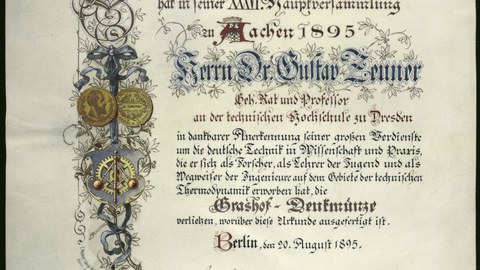Archivalienbestände im Universitätsarchiv
Die Aktenüberlieferungen im Universitätsarchiv der TU Dresden und deren Vorgängerinstitutionen seit 1800.
 © Universitätsarchiv
© Universitätsarchiv
Einführung in die Bestände des Universitätsarchivs
aktuelle Bestandsübersicht und Benutzungshinweise
Bestandsgruppe 1828 bis 1945 (Altbestand)
Der Altbestand des Archivs ist zu mehr als 50 Prozent während der alliierten Bombardierung Dresdens am 13./14. Februar 1945 vernichtet worden. Dem mutigen Einsatz von einigen Hochschulangehörigen ist es zu danken, dass dennoch aus dem zerstörten ehemals repräsentativen Hauptgebäude der Hochschule in der Nähe des Dresdner Hauptbahnhofs wichtige Akten von den Fakultäten, des Rektorats und des Rentamtes (Verwaltung) gerettet werden konnten. Dazu gehört auch ein großer Teil der Studentenakten aus dem 19. und Anfang des 20. Jahrhunderts.
Wesentlich vollständiger ist die Überlieferung der ehemaligen Forstlichen Hochschule Tharandt, die 1816 von einer privaten Forstlehranstalt unter Leitung Heinrich Cottas in eine staatliche Bildungseinrichtung als Kgl. Sächsische Forstakademie (später Kgl. Sächs. Forstliche Hochschule Tharandt) überführt wurde. Diese zweitälteste europäische Forstlehranstalt auf wissenschaftlicher Grundlage, wurde 1929 als Abteilung Forstliche Hochschule in die Technische Hochschule Dresden integriert.
Bestandsgruppe 1945 bis 1968
Diese Bestandsgruppe des Universitätsarchivs umfasst neben den Strukturen der Universitätsleitung, des Senats, der Fakultäten mit ihren Instituten, einschließlich der Arbeiter-und-Bauern-Fakultät (ABF), auch die Verwaltung der Universität mit mehreren angeschlossenen sozialen und kulturellen Einrichtungen. Diese Akten legen beispielsweise Zeugnis ab vom anfänglichen Einfluss der Sowjetischen Militäradministration (SMAD) auf die Hochschule, dem raschen und großzügigen Wiederaufbau, den baulichen Erweiterungen auf dem Campus und der strukturellen Entwicklung der größten und leistungsfähigsten technikwissenschaftlichen akademischen Ausbildungsstätte der DDR. Neben der weiterhin hohen internationalen Reputation der Hochschule werden gleichfalls die parteipolitischen Einflüsse deutlich.
Bestandsgruppe 1969 bis 1990
Diese Bestandsgruppe umfasst die Überlieferungen des Rektorats, des Senats, der Verwaltung, der Sektionen mit Instituten und Lehrstühlen sowie der gesellschaftlichen Organisationen, wie des Freien Deutschen Gewerkschaftsbundes (FDGB). Mit der Durchsetzung der vom Politbüro der SED und der Regierung der DDR 1968 initiierten so genannten 3. Hochschulreform wurde das Hoch- und Fachschulwesen der DDR weiter zentralisiert und Reste noch bestehender Autonomie gegen teilweisen Widerstand aus den Instituten abgebaut. Die Fakultäten verloren bis auf einige akademische Funktionen im Forschungsbereich ihre ursprüngliche Bedeutung.
Es wurden Sektionen als die grundlegenden wissenschaftlichen Struktureinheiten gegründet, die von Sektionsdirektoren nach dem Prinzip des demokratischen Zentralismus wiederum straff vom Rektorat und der SED-Kreisleitung angeleitet und kontrolliert wurden. Die Zahl der Sektionen war von anfänglich 22 auf 28 gestiegen und in Wissenschaftsbereiche untergliedert.
Neben den Sektionen waren Strukturen ins Leben gerufen worden, die übergeordnete gesamtuniversitäre Aufgaben wahrnahmen, wie das Rechenzentrum, das Institut für Hochschulsport und das Institut für Recht in Wissenschaft und Technik.
Während des letzten Jahrzehnts der DDR hatte sich die Universität teilweise den neuen Bedingungen des Weltmarktes und der internationalen Entwicklung angepasst. So gab es nun einen Exportbeauftragten und eine Struktur für kommerziell verwertete Studienrichtungen, um Devisen zu erwirtschaften. Gleichfalls war der Sicherheits- und Überwachungsapparat ausgebaut worden.
Weitere Institutionen, die direkt Ministerien unterstellt waren, wie das Institut für Hoch- und Fachschulbau, waren ebenfalls eng mit der Universität verknüpft und im Campus angesiedelt worden.
Im Jahre 1986 wurde die ehemalige Ingenieurhochschule Dresden (1861 als Gewerbeschule gegründet) in die Universität integriert. Sie bildete die Grundstruktur für das der TU Dresden unterstellte Informatikzentrum des Hochschulwesens der DDR, das den Rückstand der DDR auf dem Gebiet der modernen Informationstechnologien gegenüber dem Westen aufholen sollte.
Bestandsgruppe 1990 ff
Die politische Wende und die Wiedervereinigung Deutschlands hatten fundamentale Auswirkungen auf die Universität. Personalpolitische und fachliche Evaluierungen hatten zur Folge, dass der Personalbestand eine einschneidende Verringerung erfuhr und Strukturen innerhalb kürzester Fristen aufgelöst wurden. Auf der Grundlage des Gesetzes zur Struktur des Hochschulwesens und der Hochschulen im Freistaat Sachsen vom 10. April 1992 und des Gesetzes über die Hochschulen im Freistaat Sachsen vom 4. August 1993 wurden im Freistaat Sachsen sowohl die ehemalige Hochschule für Verkehrswesen "Friedrich List" sowie die Pädagogischen Hochschule "Karl-Friedrich-Wilhelm-Wander", beide 1952 gegründet, aufgelöst. Der Lehrbetrieb wurde unter neuen inhaltlichen und strukturellen Voraussetzungen an der TU Dresden fortgesetzt.
Die Archive beider Hochschulen bilden eigene Bestandsgruppen im Universitätsarchiv. Die 1954 gegründete Medizinische Akademie "Carl Gustav Carus" war die Vorgängerinstitution der 1993 ins Leben gerufenen Medizinischen Fakultät Carl Gustav Carus und des Universitätsklinikums gleichen Namens.
Das moderne nach 1990 entstandene Archivgut (auch digitale Unterlagen) steht für die allgemeine öffentliche Benutzung noch nicht Verfügung. Zu dieser Bestandsgruppe gehören die Archivalien der ersten Leitungsebene, der akademischen Selbstverwaltung, der Bereiche und Fakultäten, der Zentralen Einrichtungen, der Stabsstellen und der Dezernate.
Besondere Bestände
Zu den Beständen des Universitätsarchivs gehören weiter die Bestände der schriftlichen Nachlässe (Privatschriften), spezifische Sammlungen, die Akten der Studierenden (mit Prüfungsakten), Graduierungsakten und die Personalakten.






